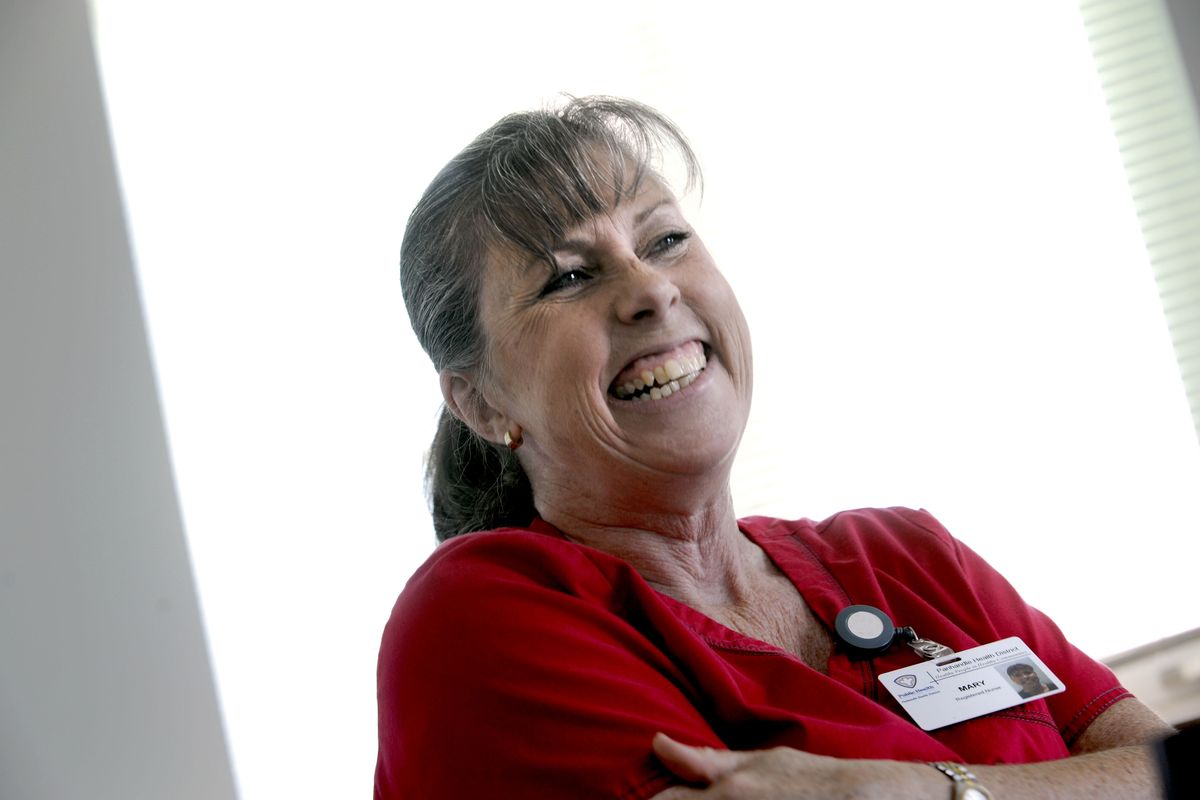Formula for home nursing
Recently named the top home health nurse in Idaho, Mary Clarke leans on her racing and other high-intensity experiences to help handle the pressures and surprises that can occur in unfamiliar environm

Her days as a race car driver serve Mary Clarke well as a home health nurse in North Idaho.
She travels daily, taking dirt roads to remote locations throughout the five counties to find some patients. She has at least once unbuckled her seat belt and readied herself, shaking with adrenalin, to leap from her car if it slid much farther down the narrow switchbacks cut into a snow-covered mountain.
But Clarke’s racing days – and her time as a trackside EMT, responding to crashes and fires – represent just one part of a life that’s prepared her for a job that inserts her regularly into unfamiliar environments, charged with not only assessing patients’ medical conditions but the conditions around them that could hurt their ability to heal.
Recently named among the top home health nurses in the U.S., Clarke works for the Panhandle Health District’s Home Health Division. Her goal is recovery for her homebound patients – people discharged from the hospital after knee surgery or abdominal surgery or cancer treatment, but still in need of care.
It’s a job that requires experience and medical knowledge, but also autonomy and keen observation skills, said Linda Karlgaard, Clarke’s clinical supervisor.
Working autonomously, home health nurses deliver care and patient education while identifying and resolving obstacles holding up their recoveries, said Linda Karlgaard, a clinical supervisor in the health district’s Home Health Division.
That might include working with patients’ families, “with all the good and the dysfunctional elements there are there,” she said.
“To be a home health nurse, it takes kind of a sixth sense to be able to tell what is really happening, and to try to remove the barriers that keep a person from healing,” Karlgaard said. “She has a very good sense of safety. She has a very good sense of what is going on in the homes. She’s street smart.”
Clarke, 53, was named the top home health nurses in Idaho by the National Association for Home Care & Hospice, which sifted through nominations from 33,000 people nationwide to choose one nurse from each state.
She is one of about 18 people working in the Home Health Division, including other nurses, social workers and occupational, speech and physical therapists. The North Idaho health district is the only one in the state to offer home health services, usually paid for by patients’ insurance, spokeswoman Cynthia Taggart said. Referred by doctors and hospitals, most are on Medicare.
One measure of Clarke’s success is her low “rehospitalization” rate, said Karlgaard. About 4 percent of Clarke’s patients must return to a hospital for care despite her efforts, compared with a national average of 20 to 25 percent, Karlgaard said.
Besides street smarts, Clarke taps her broad experience with patients, whether they were climbing out of burning cars or turning up in a crowded trauma center.
Growing up in Las Vegas, Clarke treated the desert as her playground, racing dune buggies and motorcycles across the sand.
Later, she took some turns behind the wheel as a Formula driver, spinning around paved tracks – and, as her interest in medicine grew, serving as an EMT, then becoming a licensed practical nurse before finally earning her credentials as a registered nurse. The going in nursing school was slow for Clarke, a single mother of a daughter, Tina, taking a couple of classes here, a couple there.
Clarke spent 13 years in a level-one trauma center in Las Vegas, working various jobs: operating room, intensive care, emergency room.
“I saw everything that walks in life. A lot of gunshots, a lot of stabbings, and I probably have seen more people who have died in a month than people would see in a lifetime, unless you’re in a war.
“You learn by patients, you learn by families,” Clarke said. “You probably even learn by the gangbangers who want to come in and shoot you.”
She joined the Panhandle Health District seven years ago.
Without her experience at the trauma center, Clarke said, she’d be “lost out there,” in the corners and neighborhoods of North Idaho.
As a home health nurse, she said, there’s no pulling in another nurse from a hospital corridor to listen to the strange sounds emanating from a patient’s lungs. It’s up to her to understand what those lung sounds mean and relate the information to a doctor – or send her patient to an emergency room.
She leaves the beaten path figuratively, too, veering from traditional nursing duties to help ensure her patients’ recovery. Recently, she worked to track down an air conditioner for a mobile home she knew was too hot for one patient, a sick baby, to stay in.
And she has had to tell patients: I’m sorry. You can’t be here alone. It’s not safe.
“You’ve got to be able to assess a situation, to address it,” she said.
In a home health industry magazine article about nurses honored by the national association, Clarke wrote about her work with Millie Francis, a Kootenai County resident who has endured celiac disease, chronic obstructive pulmonary disease, breast cancer (twice), and an operation to treat duodenal cancer, which starts in the small intestine.
“Millie is a tiny lady who weighs just 98 pounds,” Clarke wrote. “Yet she is strongly determined to beat the odds, presenting me with a number of challenges and rewards as I strive to improve her life. I educate her about her condition so she knows what to report to keep her out of the hospital and in her home. I coordinate with her physicians and her family so she feels safe. And I ask myself every day what else I can do to improve her life.”